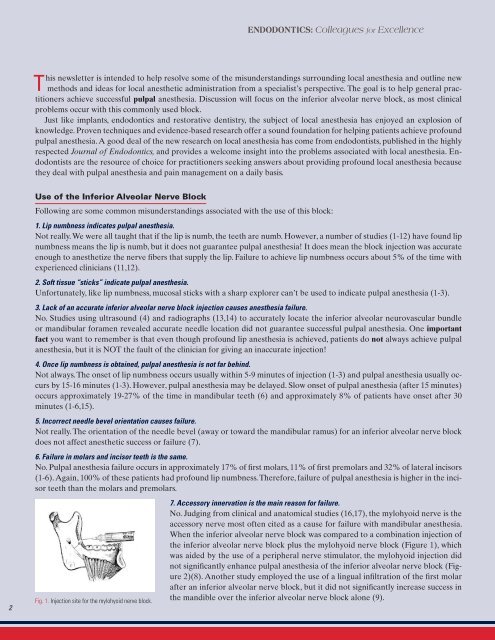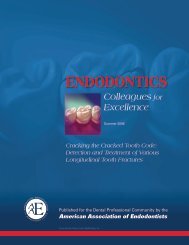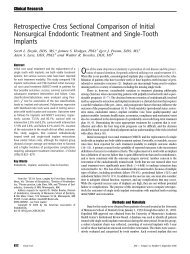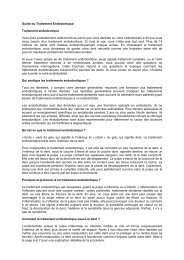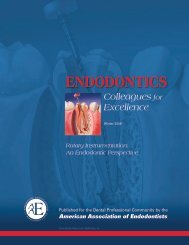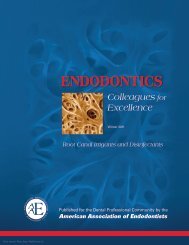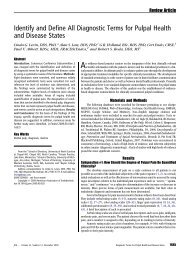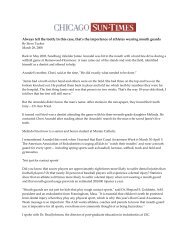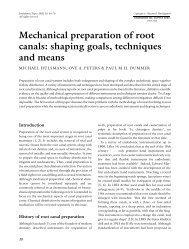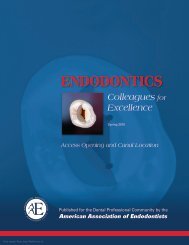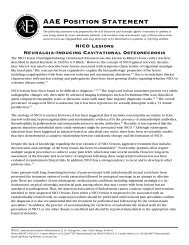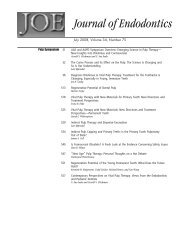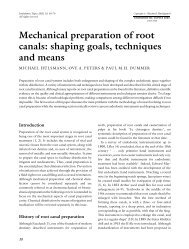Taking the Pain out of Restorative Dentistry and Endodontics
Taking the Pain out of Restorative Dentistry and Endodontics
Taking the Pain out of Restorative Dentistry and Endodontics
Create successful ePaper yourself
Turn your PDF publications into a flip-book with our unique Google optimized e-Paper software.
2<br />
T<br />
his newsletter is intended to help resolve some <strong>of</strong> <strong>the</strong> misunderst<strong>and</strong>ings surrounding local anes<strong>the</strong>sia <strong>and</strong> <strong>out</strong>line new<br />
methods <strong>and</strong> ideas for local anes<strong>the</strong>tic administration from a specialist’s perspective. The goal is to help general practitioners<br />
achieve successful pulpal anes<strong>the</strong>sia. Discussion will focus on <strong>the</strong> inferior alveolar nerve block, as most clinical<br />
problems occur with this commonly used block.<br />
Just like implants, endodontics <strong>and</strong> restorative dentistry, <strong>the</strong> subject <strong>of</strong> local anes<strong>the</strong>sia has enjoyed an explosion <strong>of</strong><br />
knowledge. Proven techniques <strong>and</strong> evidence-based research <strong>of</strong>fer a sound foundation for helping patients achieve pr<strong>of</strong>ound<br />
pulpal anes<strong>the</strong>sia. A good deal <strong>of</strong> <strong>the</strong> new research on local anes<strong>the</strong>sia has come from endodontists, published in <strong>the</strong> highly<br />
respected Journal <strong>of</strong> <strong>Endodontics</strong>, <strong>and</strong> provides a welcome insight into <strong>the</strong> problems associated with local anes<strong>the</strong>sia. Endodontists<br />
are <strong>the</strong> resource <strong>of</strong> choice for practitioners seeking answers ab<strong>out</strong> providing pr<strong>of</strong>ound local anes<strong>the</strong>sia because<br />
<strong>the</strong>y deal with pulpal anes<strong>the</strong>sia <strong>and</strong> pain management on a daily basis.<br />
Use <strong>of</strong> <strong>the</strong> Inferior Alveolar Nerve Block<br />
Following are some common misunderst<strong>and</strong>ings associated with <strong>the</strong> use <strong>of</strong> this block:<br />
<strong>Endodontics</strong>: Colleagues for Excellence<br />
1. Lip numbness indicates pulpal anes<strong>the</strong>sia.<br />
Not really. We were all taught that if <strong>the</strong> lip is numb, <strong>the</strong> teeth are numb. However, a number <strong>of</strong> studies (1-12) have found lip<br />
numbness means <strong>the</strong> lip is numb, but it does not guarantee pulpal anes<strong>the</strong>sia! It does mean <strong>the</strong> block injection was accurate<br />
enough to anes<strong>the</strong>tize <strong>the</strong> nerve fibers that supply <strong>the</strong> lip. Failure to achieve lip numbness occurs ab<strong>out</strong> 5% <strong>of</strong> <strong>the</strong> time with<br />
experienced clinicians (11,12).<br />
2. S<strong>of</strong>t tissue “sticks” indicate pulpal anes<strong>the</strong>sia.<br />
Unfortunately, like lip numbness, mucosal sticks with a sharp explorer can’t be used to indicate pulpal anes<strong>the</strong>sia (1-3).<br />
3. Lack <strong>of</strong> an accurate inferior alveolar nerve block injection causes anes<strong>the</strong>sia failure.<br />
No. Studies using ultrasound (4) <strong>and</strong> radiographs (13,14) to accurately locate <strong>the</strong> inferior alveolar neurovascular bundle<br />
or m<strong>and</strong>ibular foramen revealed accurate needle location did not guarantee successful pulpal anes<strong>the</strong>sia. One important<br />
fact you want to remember is that even though pr<strong>of</strong>ound lip anes<strong>the</strong>sia is achieved, patients do not always achieve pulpal<br />
anes<strong>the</strong>sia, but it is NOT <strong>the</strong> fault <strong>of</strong> <strong>the</strong> clinician for giving an inaccurate injection!<br />
4. Once lip numbness is obtained, pulpal anes<strong>the</strong>sia is not far behind.<br />
Not always. The onset <strong>of</strong> lip numbness occurs usually within 5-9 minutes <strong>of</strong> injection (1-3) <strong>and</strong> pulpal anes<strong>the</strong>sia usually occurs<br />
by 15-16 minutes (1-3). However, pulpal anes<strong>the</strong>sia may be delayed. Slow onset <strong>of</strong> pulpal anes<strong>the</strong>sia (after 15 minutes)<br />
occurs approximately 19-27% <strong>of</strong> <strong>the</strong> time in m<strong>and</strong>ibular teeth (6) <strong>and</strong> approximately 8% <strong>of</strong> patients have onset after 30<br />
minutes (1-6,15).<br />
5. Incorrect needle bevel orientation causes failure.<br />
Not really. The orientation <strong>of</strong> <strong>the</strong> needle bevel (away or toward <strong>the</strong> m<strong>and</strong>ibular ramus) for an inferior alveolar nerve block<br />
does not affect anes<strong>the</strong>tic success or failure (7).<br />
6. Failure in molars <strong>and</strong> incisor teeth is <strong>the</strong> same.<br />
No. Pulpal anes<strong>the</strong>sia failure occurs in approximately 17% <strong>of</strong> first molars, 11% <strong>of</strong> first premolars <strong>and</strong> 32% <strong>of</strong> lateral incisors<br />
(1-6). Again, 100% <strong>of</strong> <strong>the</strong>se patients had pr<strong>of</strong>ound lip numbness. Therefore, failure <strong>of</strong> pulpal anes<strong>the</strong>sia is higher in <strong>the</strong> incisor<br />
teeth than <strong>the</strong> molars <strong>and</strong> premolars.<br />
Fig. 1. Injection site for <strong>the</strong> mylohyoid nerve block.<br />
7. Accessory innervation is <strong>the</strong> main reason for failure.<br />
No. Judging from clinical <strong>and</strong> anatomical studies (16,17), <strong>the</strong> mylohyoid nerve is <strong>the</strong><br />
accessory nerve most <strong>of</strong>ten cited as a cause for failure with m<strong>and</strong>ibular anes<strong>the</strong>sia.<br />
When <strong>the</strong> inferior alveolar nerve block was compared to a combination injection <strong>of</strong><br />
<strong>the</strong> inferior alveolar nerve block plus <strong>the</strong> mylohyoid nerve block (Figure 1), which<br />
was aided by <strong>the</strong> use <strong>of</strong> a peripheral nerve stimulator, <strong>the</strong> mylohyoid injection did<br />
not significantly enhance pulpal anes<strong>the</strong>sia <strong>of</strong> <strong>the</strong> inferior alveolar nerve block (Figure<br />
2)(8). Ano<strong>the</strong>r study employed <strong>the</strong> use <strong>of</strong> a lingual infiltration <strong>of</strong> <strong>the</strong> first molar<br />
after an inferior alveolar nerve block, but it did not significantly increase success in<br />
<strong>the</strong> m<strong>and</strong>ible over <strong>the</strong> inferior alveolar nerve block alone (9).


